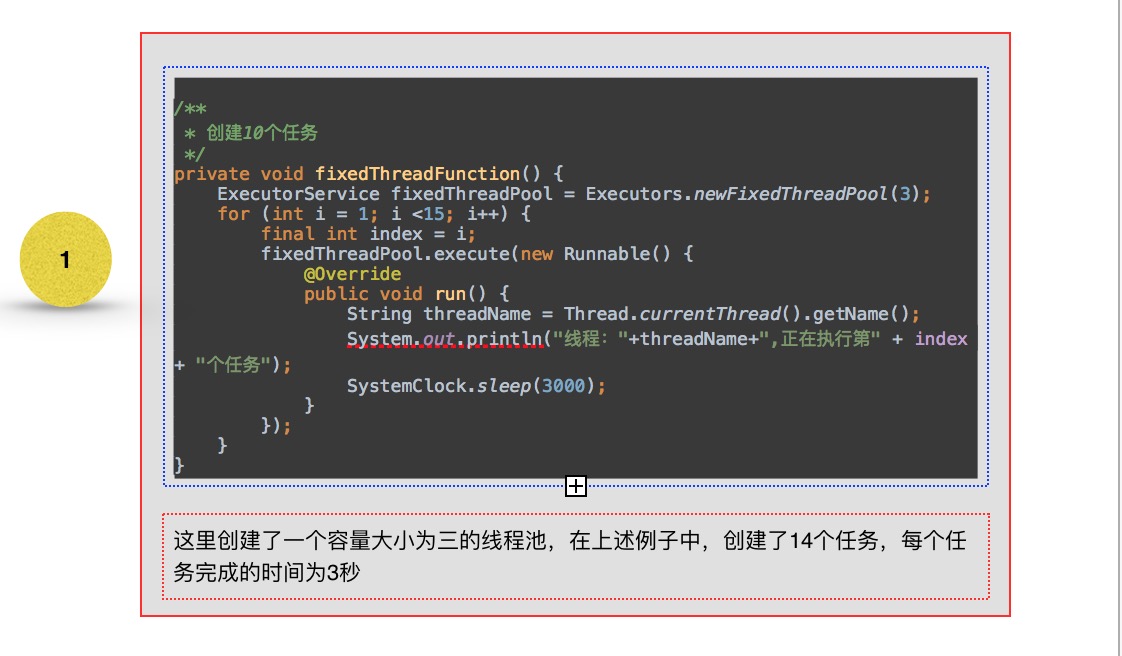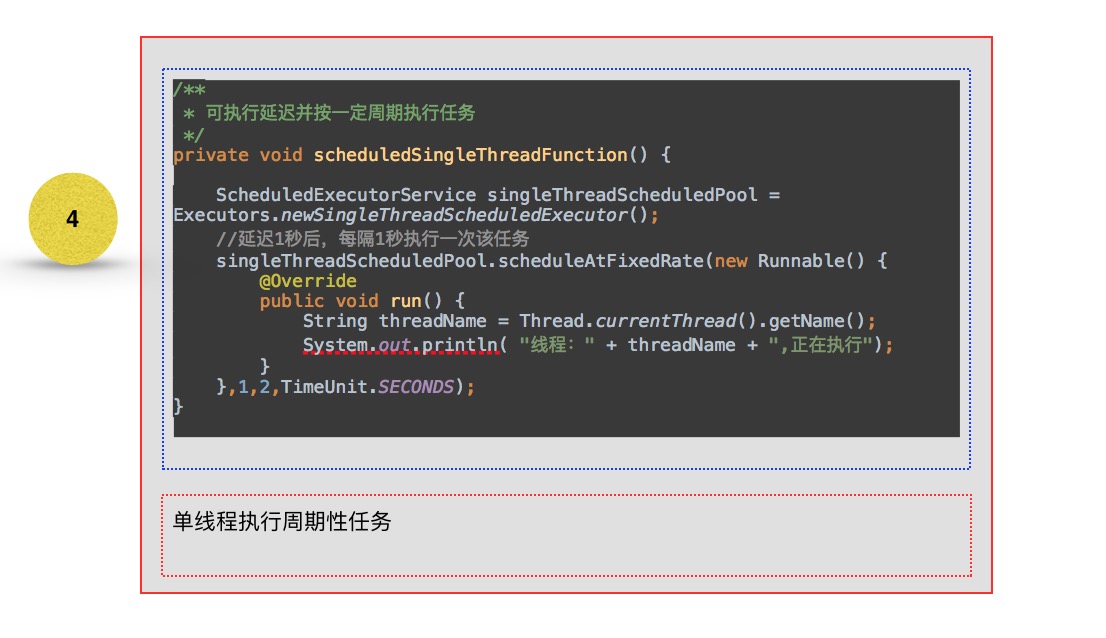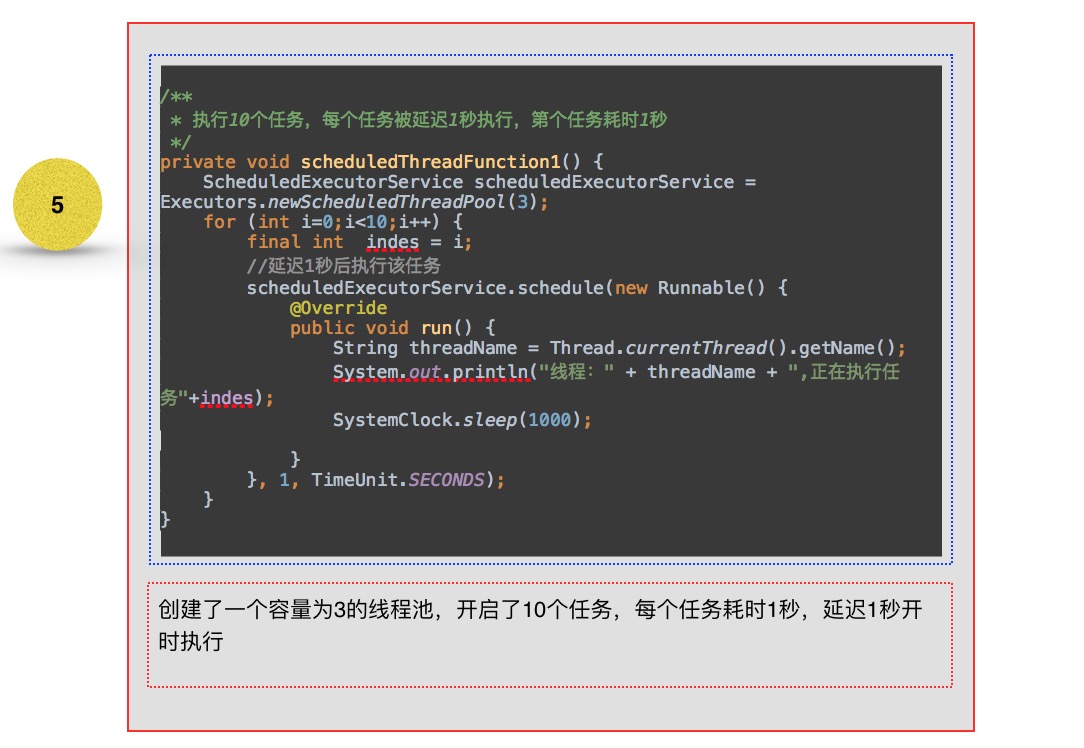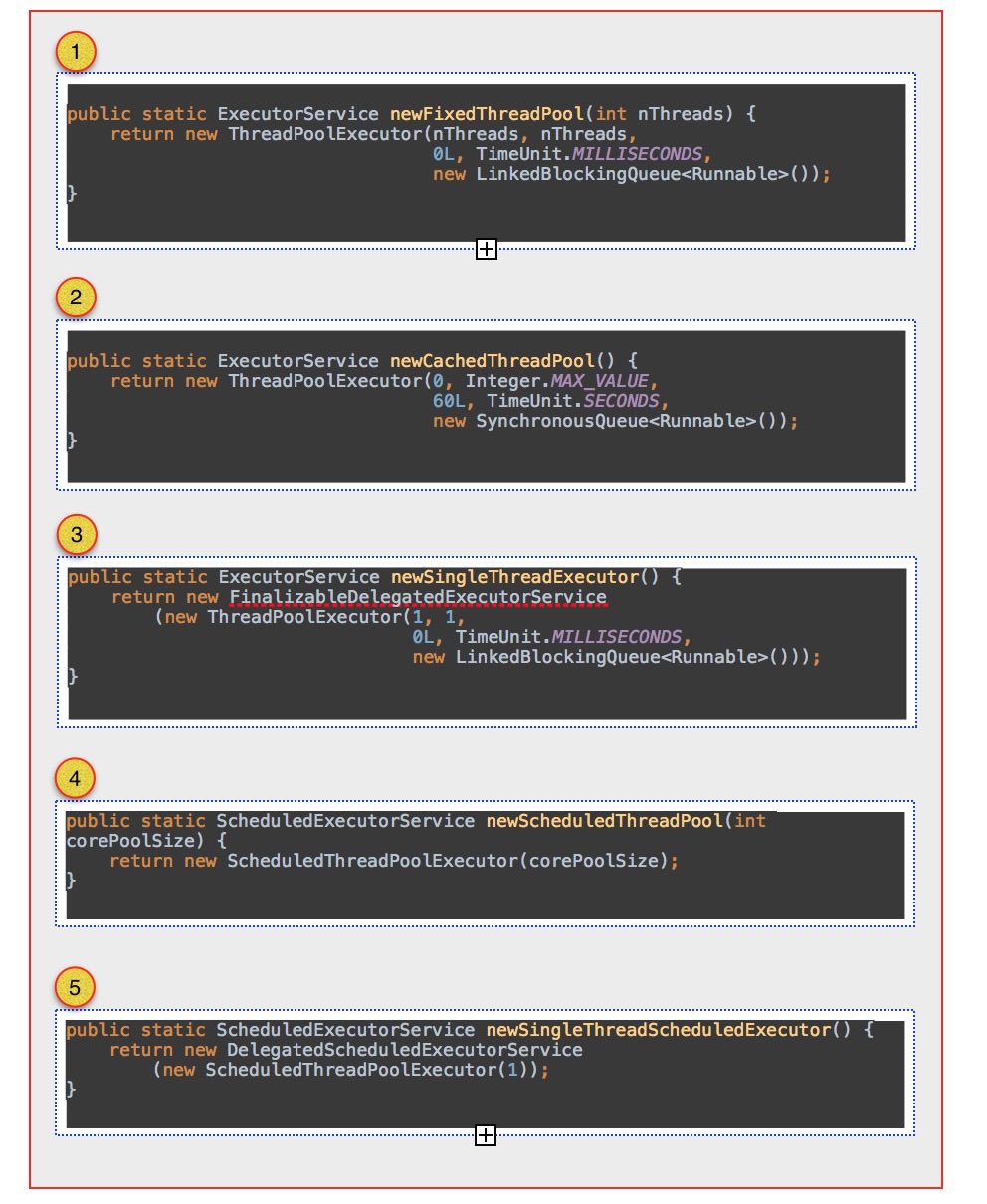题记——
难过了,悄悄走一走;
伤心了,默默睡一觉;
优雅不是训练出来的,而是一种阅历;
淡然不是伪装出来的,而是一种沉淀;
时间飞逝,老去的只是我们的容颜;
时间仿佛一颗灵魂,越来越动人;
其他站点:
1、回享每一时刻 http://jingyan.baidu.com/article/25648fc193fcbe9190fd004f.html
2、回眸每一点钟 http://blog.csdn.net/zl18603543572/article/details/52012122
1、简述:
在多线程的世界中,是那么的神奇 与 高效以及合理;
2、创建线程池实例
官方推荐使用Executors类工厂方法来创建线程池管理,Executors类是官方提供的一个工厂类,里面封装了好多功能不一样的线程池,从而使得我们创建线程池非常的简单:

3、使用线程池来管理任务






4、Executors核心创建说明

可以看到1 - 3 创建线程池的方法中,全部是创建了ThreadPoolExecutor这个对象实例,不同的只是构造中的参数不一至,而在4 与5 ,从其继承的角度来看
public class ScheduledThreadPoolExecutor
extends ThreadPoolExecutor
implements ScheduledExecutorService {
可以看到其实质也是继承于ThreadPoolExecutor这个对象实例。
也就是说上述一种类型的线程池其都是 ThreadPoolExecutor子类,其实直接创建ThreadPoolExecutor实例对象,只需要传入相对应的配制参数,就可以创建出来与上述五种效果相一至的线程池管理,只不过是在书写的时候太过于繁锁。
/**
* Creates a new {@code ThreadPoolExecutor} with the given initial
* parameters and default thread factory and rejected execution handler.
* It may be more convenient to use one of the {@link Executors} factory
* methods instead of this general purpose constructor.
*
* @param corePoolSize the number of threads to keep in the pool, even
* if they are idle, unless {@code allowCoreThreadTimeOut} is set
* @param maximumPoolSize the maximum number of threads to allow in the
* pool
* @param keepAliveTime when the number of threads is greater than
* the core, this is the maximum time that excess idle threads
* will wait for new tasks before terminating.
* @param unit the time unit for the {@code keepAliveTime} argument
* @param workQueue the queue to use for holding tasks before they are
* executed. This queue will hold only the {@code Runnable}
* tasks submitted by the {@code execute} method.
* @throws IllegalArgumentException if one of the following holds:<br>
* {@code corePoolSize < 0}<br>
* {@code keepAliveTime < 0}<br>
* {@code maximumPoolSize <= 0}<br>
* {@code maximumPoolSize < corePoolSize}
* @throws NullPointerException if {@code workQueue} is null
*/
public ThreadPoolExecutor(int corePoolSize,
int maximumPoolSize,
long keepAliveTime,
TimeUnit unit,
BlockingQueue<Runnable> workQueue) {
this(corePoolSize, maximumPoolSize, keepAliveTime, unit, workQueue,
Executors.defaultThreadFactory(), defaultHandler);
}
5、ThreadPoolExecutor简述
从上述创建ThreadPoolEecutor实例的构造来说,

6、自定义线程池
/**
* 创建线程池也是需要资源的,所以线程池内线程数量的大小也会影响系统的性能,
* 大了反而浪费资源,小了反而影响系统的吞吐量,
* 所以我们创建线程池需要把握一个度才能合理的发挥它的优点,
* 通常来说我们要考虑的因素有CPU的数量、内存的大小、并发请求的数量等因素,按需调整。
*通常核心线程数可以设为CPU数量+1,而最大线程数可以设为CPU的数量*2+1。
*/
private void customThreadFunction() {
/**
* 获取CPU数量
*/
int processors = Runtime.getRuntime().availableProcessors();
/**
* 核心线程数量
*/
int corePoolSize =processors + 1;
/**
* 最大线程数量
*/
int maximumPoolSize = processors * 2 + 1;
/**
* 空闲有效时间
*/
long keepAliveTime = 60;
/**
* 创建自定义线程池
*/
ThreadPoolExecutor threadPoolExecutor = new ThreadPoolExecutor(corePoolSize, maximumPoolSize, keepAliveTime, TimeUnit.SECONDS, new PriorityBlockingQueue());
/**
* 添加执行任务
*/
for (int i=1;i<=20;i++){
final int prites = i;
threadPoolExecutor.execute(new CustomRunnable(prites){
@Override
public void doRun() {
String name = Thread.currentThread().getName();
System.out.println("curentThread name is "+name +"and prites is "+prites);
SystemClock.sleep(1000);
}
});
}
}
public abstract class CustomRunnable implements Runnable,Comparable<CustomRunnable> {
private int priority;
public CustomRunnable(int priority) {
if (priority<0)
throw new IllegalArgumentException();
this.priority = priority;
}
@Override
public int compareTo(CustomRunnable another) {
int my = this.getPriority();
int other = another.getPriority();
if (my>other){
return -1;
}else{
return 0;
}
}
@Override
public void run() {
doRun();
}
public abstract void doRun();
public int getPriority() {
return priority;
}
}
7、自定义扩展线程池
public class CustomExpanThreadPool extends ThreadPoolExecutor {
private CustomExpanThreadPool(int corePoolSize, int maximumPoolSize, long keepAliveTime, TimeUnit unit, BlockingQueue<Runnable> workQueue) {
super(corePoolSize, maximumPoolSize, keepAliveTime, unit, workQueue);
}
public static CustomExpanThreadPool getInstance() {
/**
* 获取CPU数量
*/
int processors = Runtime.getRuntime().availableProcessors();
/**
* 核心线程数量
*/
int corePoolSize = processors + 1;
/**
* 最大线程数量
*/
int maximumPoolSize = processors * 2 + 1;
/**
* 空闲有效时间
*/
long keepAliveTime = 60;
/**
* 创建自定义线程池
*/
return new CustomExpanThreadPool(corePoolSize, maximumPoolSize, keepAliveTime, TimeUnit.SECONDS, new PriorityBlockingQueue());
}
/**
* 用于控制线程开始与停止执行的方法
*/
private boolean isPaused;
private ReentrantLock pauseLock = new ReentrantLock();
private Condition unpaused = pauseLock.newCondition();
/**
* 任务执行前要执行的方法
*
* @param t
* @param r
*/
@Override
protected void beforeExecute(Thread t, Runnable r) {
super.beforeExecute(t, r);
System.out.println(Thread.currentThread().getName() + " 任务执行开始 ");
pauseLock.lock();
try {
while (isPaused) unpaused.await();
} catch (InterruptedException ie) {
t.interrupt();
} finally {
}
}
/**
* 任务执行后要执行的方法
*
* @param r
* @param t
*/
@Override
protected void afterExecute(Runnable r, Throwable t) {
super.afterExecute(r, t);
System.out.println(Thread.currentThread().getName() + " 任务执行over ");
}
/**
* 线程池关闭后要执行的方法
*/
@Override
protected void terminated() {
super.terminated();
}
/**
* 暂停执行任务的方法
*/
public void pause() {
pauseLock.lock();
try {
isPaused = true;
} finally {
pauseLock.unlock();
}
}
/**
* 恢复执行任务的方法
*/
public void resume() {
pauseLock.lock();
try {
isPaused = false;
unpaused.signalAll();
} finally {
pauseLock.unlock();
}
}
}
使用:
private void customThreadFunction2() {
CustomExpanThreadPool threadPoolExecutor = CustomExpanThreadPool.getInstance();
/**
* 添加执行任务
*/
for (int i=1;i<=20;i++){
final int prites = i;
threadPoolExecutor.execute(new CustomRunnable(prites){
@Override
public void doRun() {
String name = Thread.currentThread().getName();
System.out.println("curentThread name is "+name +"and prites is "+prites);
SystemClock.sleep(1000);
}
});
}
}
8、自定义线程池与可控制取消的任务
首先创建自定义的线程池(与标签7)
/**
* CPU数量
*/
private int process = Runtime.getRuntime().availableProcessors();
/**
* 核心线程数量
*/
private int corePoolSize = process + 1;
/**
* 最大线程数量
*/
private int maxPoolSize = process * 2 + 1;
/**
* 空闲有效时间
*/
private long keepAliveTime = 60;
/**
* 自定义线程池
*/
private ThreadPoolExecutor mThreadPoolExecutor;
/**
* 用于保存任务的集合
*/
private Map<String, Future<Integer>> mThreadFutureTaskMap;
private ThreadPoolManager(){
if (mThreadPoolExecutor == null) {
synchronized (ThreadPoolManager.class){
if (mThreadPoolExecutor == null) {
init();
}
}
}
}
public void init() {
/**
* 初始化创建线程池
*/
mThreadPoolExecutor = new ThreadPoolExecutor(corePoolSize,
maxPoolSize,
keepAliveTime,
TimeUnit.SECONDS,
new LinkedBlockingQueue<Runnable>()) {
private boolean isPaused;
private ReentrantLock pauseLock = new ReentrantLock();
private Condition unpaused = pauseLock.newCondition();
@Override
protected void beforeExecute(Thread t, Runnable r) {
pauseLock.lock();
try {
while (isPaused) unpaused.await();
} catch (InterruptedException ie) {
t.interrupt();
} finally {
pauseLock.unlock();
}
}
/**
* 暂停
*/
public void pauseThreadPool() {
pauseLock.lock();
try {
isPaused = true;
} finally {
pauseLock.unlock();
}
}
/**
* 恢复任务
*/
public void resumeThreadPool() {
pauseLock.lock();
try {
isPaused = false;
unpaused.signalAll();
} finally {
pauseLock.unlock();
}
}
};
/**
* 初始化保存任务的集合
*/
mThreadFutureTaskMap = new HashMap<>();
}
然后就是创建用于控制任务的回调
public abstract class ThreadPoolCallable implements Callable<Integer> {
@Override
public Integer call() throws Exception {
runCall();
return 1;
}
public abstract void runCall();
}
关于ThreadPoolCallable
可以看到这里是继承于Callable,call方法中的回调返回的信息可以通过些任务对象回调得到,当然异步方法也是在call方法中执行
然后就是向线程池内添加任务
/**
* 添加单个任务
*@param keyTag 任务的标签
* @param task 任务
* @return 任务对象
*/
public Future addTask(ProrityPoolCallable task, String keyTag) {
//添加并提交任务
RunnableFuture futureTask = (RunnableFuture) mThreadPoolExecutor.submit(task);
//将任务添加到集合中
Future put = mThreadFutureTaskMap.put(keyTag, futureTask);
return futureTask;
}
将每个任务提交给线程池管理,然后会返回一个Future对象,看其源码会发现其最终继承Runable对象,然后呢我们将这个Future对象以key,value形式存储到Map集合中去,目的是当我们要取消一个任务的时候,当这个任务已经被提交到线程池中,未执行或者是正在执行,我们都可以通过传的KEY,然后再从集合中取出Key对应的Futureccf对象,然后执行cancel方法,就可以取消这个任务了
取消任务
/**
* 移除单个任务
* @param key 任务标签
* @return true 为成功
*/
public boolean removeTask(String key) {
//任务移除标识
boolean cancel = false;
//根据KEY来获取对应的Future对象
Set<String> keySet = mThreadFutureTaskMap.keySet();
if (keySet.contains(key)) {
Future<Integer> future = mThreadFutureTaskMap.get(key);
//当前的任务已经被执行完毕,不进行操作
if (!future.isCancelled()) {
cancel = future.cancel(true);
if (cancel) {
//当取消成功后,从本地Key集合中移除标识
mThreadFutureTaskMap.remove(key);
}
}else{
mThreadFutureTaskMap.remove(key);
}
}
return cancel;
}
来源:oschina
链接:https://my.oschina.net/u/2447911/blog/716828